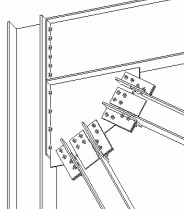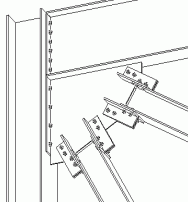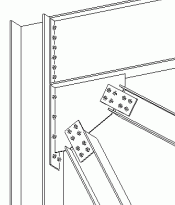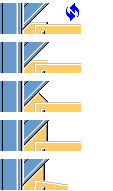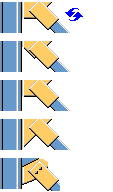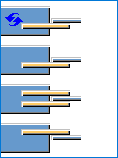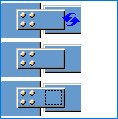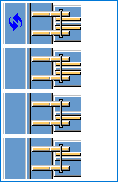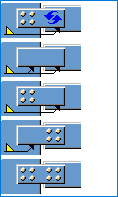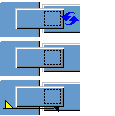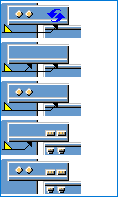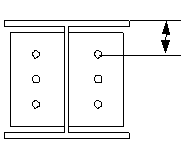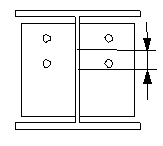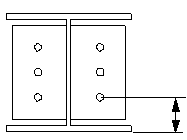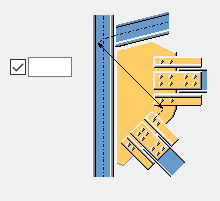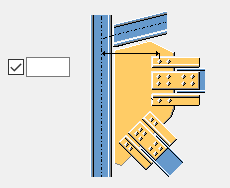Corner wrapped gusset (63)
Corner wrapped gusset (63) bolts 1 to 10 braces to a gusset plate where two parts form a corner, using clip angles and connection plates. Welds the gusset plate to one of the parts that form the corner.
Objects created
-
Gusset plate
-
Connection plate between the gusset plate and the brace web
-
Shear tab between the gusset plate and the brace flange
-
Clip angles
-
Shim plates
-
Stiffeners
-
Bolts
-
Welds
Use for
| Situation | Description |
|---|---|
|
|
Brace profile: W Gusset plate is welded to an extended end plate. Braces are bolted to the gusset plate using clip angles on the flanges and connection plates on the webs. |
|
|
Brace profile: W Gusset plate is welded to an extended end plate. Braces are bolted to the gusset plate using clip angles on the flanges. |
|
|
Brace profile: W Gusset plate is welded to an extended end plate. Braces are bolted to the gusset plate using connection plates on the webs. |
Before you start
Create two parts that form a corner, and 1 to 10 braces.
Tekla Structures uses values in the joints.def file to create this component.
Selection order
-
Select the main part (the first part that forms the corner).
-
Select the secondary part (first brace).
-
Select the second secondary part (second brace).
-
Select the subsequent secondary parts (subsequent braces).
-
Select the secondary part that forms the corner.
-
Click the middle mouse button to create the component.
Part identification key
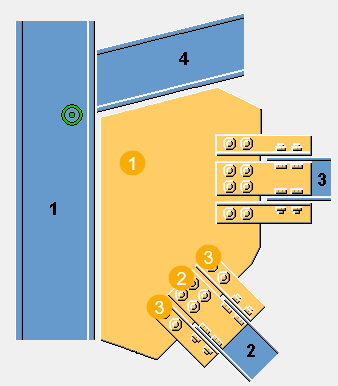
| Description | |
|---|---|
|
1 |
Gusset plate |
|
2 |
Connection plate |
|
3 |
Clip angle |
Picture tab
Use the Picture tab to define the dimensions that control the position and shape of the gusset plate.
Dimensions
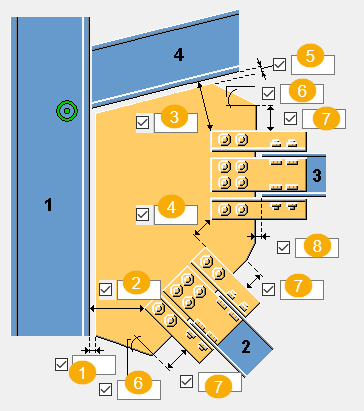
| Description | |
|---|---|
|
1 |
Define the gap distance between the gusset plate edge and the main part. |
|
2 |
Define the edge distance between the main part and the clip angle. |
|
3 |
Define the edge distance between the clip angle and the last secondary part. |
|
4 |
Define the edge distance between the clip angles. |
|
5 |
Define the gap distance between the gusset plate edge and the second part. |
|
6 |
Define the gusset plate corner angle (in degrees). This value affects the gusset plate shape. |
|
7 |
Define the length of the edge of the gusset plate. This value affects the gusset plate shape. |
|
8 |
Define the distance between the gusset plate and the brace. |
Gusset tab
Use the Gusset tab to control the gusset plate properties.
Gusset plate
| Option | Description |
|---|---|
|
Gusset |
Thickness, width and height of the gusset plate. |
|
Option |
Description |
Default |
|---|---|---|
|
Pos_No |
Prefix and start number for the part position number. Some components have a second row of fields where you can enter the assembly position number. |
The default part start number is defined in the Components settings in . |
|
Material |
Material grade. |
The default material is defined in the Part material box in the Components settings in . |
|
Name |
Name that is shown in drawings and reports. |
The following examples show only some of the available options. You will find more options on the Gusset tab.
Gusset plate position on the brace
Define where to place the gusset plate on the brace. If needed, you can fine-tune the gusset plate position by moving the gusset plate in the z or in the y direction.
| Option | Description |
|---|---|
|
|
Default Gusset plate is positioned in the middle of the brace. AutoDefaults can change this option. |
|
|
Gusset plate is positioned on the top flange of the brace. |
|
|
Define how much the gusset plate is moved in the z direction. |
|
|
Define how much the gusset plate is moved in the y direction. |
Gusset plate shape
When you select the option to optimize the gusset plate weight, you can define whether the selection order of the braces affects the position of the braces.
| Option | Description |
|---|---|
|
|
Default AutoDefaults can change this option. |
|
|
This option optimizes the gusset plate weight. |
Gusset plate shape
The gusset plate edge can be perpendicular either to the main part or the secondary part.
| Option | Description |
|---|---|
|
|
Select the gusset plate edge shape between the last and second last secondary part. |
|
|
Select the gusset plate egde shape between the main part and the first secondary part. |
Gusset plate fitting
| Option | Description |
|---|---|
|
|
Select whether the gusset is fitted to the last selected secondary part. |
Gusset welding
| Option | Description |
|---|---|
|
|
Default Gusset plate is welded to the main part. AutoDefaults can change this option. |
|
|
Gusset plate is welded to the main part. |
|
|
Gusset plate is welded to the secondary part. |
Gusset plate inner corner
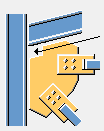
Define the horizontal and vertical chamfer dimensions.
| Option | Description |
|---|---|
|
|
Default No chamfer AutoDefaults can change this option. |
|
|
No chamfer |
|
|
Line chamfer |
|
|
Convex chamfer |
|
|
Concave chamfer |
|
|
Bevel |
|
|
Square |
Brace conn tab
Use the Brace conn tab to control connection plate, clip angle, filler plate, and shear tab properties.
Plates
| Option | Description |
|---|---|
|
Connection plate |
Thickness and width of the connection plate. Select the connection plate profile. |
|
Upper clip angle Lower clip angle |
Select the clip angle profile. |
|
Filler plate |
Thickness of the filler plate. |
|
Upper shear tab |
Thickness, width and height of the upper shear tab. |
|
Lower shear tab |
Height of the lower shear tab. |
|
Option |
Description |
Default |
|---|---|---|
|
Pos_No |
Prefix and start number for the part position number. Some components have a second row of fields where you can enter the assembly position number. |
The default part start number is defined in the Components settings in . |
|
Material |
Material grade. |
The default material is defined in the Part material box in the Components settings in . |
|
Name |
Name that is shown in drawings and reports. |
Plate creation
| Option | Description |
|---|---|
|
|
Select whether one or two connection plates are created between the brace web and the gusset plate. |
|
|
Select whether a filler plate is created between the connection plate and the brace web. The default is that a filler plate is not created. |
|
|
Select the filler plate creation side. You can use this option when you have selected to create two connection plates. |
Clip angle creation
Define whether the braces are attached to the gusset plate using clip angles or shear tabs, and specify the number of clip angles to create. The default option is to create two clip angles below the brace web.
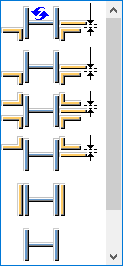

Clip angle orientation
Define how the clip angle is placed on the connection.
| Option | Description |
|---|---|
|
|
Default Clip angle is placed on the connection so that the longer leg is connected to the gusset plate. AutoDefaults can change this option. |
|
|
Clip angle is placed on the connection so that the longer leg is connected to the main part. |
Connection type
| Option | Description |
|---|---|
|
|
Select the connection type (weld or bolts) between the gusset plate and the connection plate. |
|
|
When a filler plate is created, select whether to create a weld between the filler plate and the secondary part. You can use this setting when the connection type is bolts. |
|
|
Select the connection type (weld or bolt) between the gusset plate and the clip angle. |
L profile/plate bolt main part
| Option | Description |
|---|---|
|
Gusset Bolt |
Select the bolt main part: Gusset or L profile/plate. |
Connection plate gap dimensions

| Description | |
|---|---|
|
1 |
Horizontal gap dimension |
|
2 |
Vertical gap dimension |
Shim plates tab
Use the Shim plates tab to define shim plate properties.
Plates
| Option | Description |
|---|---|
|
Shim plate 1 Shim plate 2 Shim plate 2 |
Thickness, width and height of the shim plate. |
|
Option |
Description |
Default |
|---|---|---|
|
Pos_No |
Prefix and start number for the part position number. Some components have a second row of fields where you can enter the assembly position number. |
The default part start number is defined in the Components settings in . |
|
Material |
Material grade. |
The default material is defined in the Part material box in the Components settings in . |
|
Name |
Name that is shown in drawings and reports. |
Shim plate position
You can create shim plates when connecting braces to the gusset plate using clip angles.
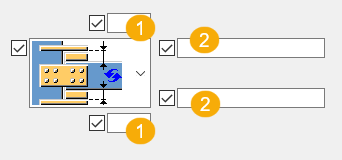
| Description | |
|---|---|
|
1 |
Define the gap between the brace and connection plate. |
|
2 |
Define how many shim plates are created at the top and bottom flanges. Enter the shim plate profile numbers: 1, 2 or 3. These are the numbers that are on the upper part on the Shim plates tab. For example, if you want to create three shim plates at the top flange, and you want to use Shim plate 1 twice and Shim plate 1 once, enter 1 1 2. The first number you enter is the shim plate closest to the brace flange. |
Stiffeners tab
Use the Stiffeners tab to control the stiffener properties and dimensions.
Stiffeners
| Option | Description |
|---|---|
|
Stiffener 1 Stiffener 2 |
Thickness of the stiffener. |
|
Option |
Description |
Default |
|---|---|---|
|
Pos_No |
Prefix and start number for the part position number. Some components have a second row of fields where you can enter the assembly position number. |
The default part start number is defined in the Components settings in . |
|
Material |
Material grade. |
The default material is defined in the Part material box in the Components settings in . |
|
Name |
Name that is shown in drawings and reports. |
Stiffener length
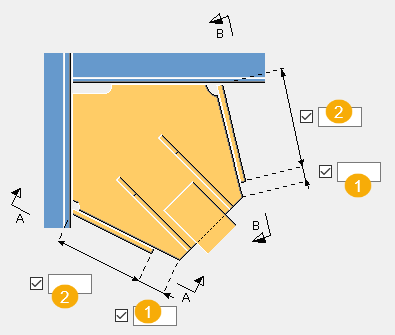
| Description | |
|---|---|
|
1 |
Distance between the stiffener edge and the gusset plate edge. |
|
2 |
Length of stiffener. |
Stiffener dimensions
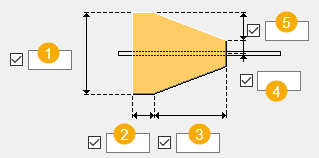
| Description | |
|---|---|
|
1 |
Width of the stiffener. |
|
2 |
Length of the stiffener base. |
|
3 |
Length of the skew part of the stiffener. |
|
4 |
Distance from the stiffener center line. |
|
5 |
Vertical distance between the stiffener base and the skew part. |
Brace bolts 1 / Brace bolts 2 tab
Use the Brace bolts 1 and Brace bolts 2 tabs to control the bolts that connect the first and second brace to the gusset plate.
Bolt group dimensions
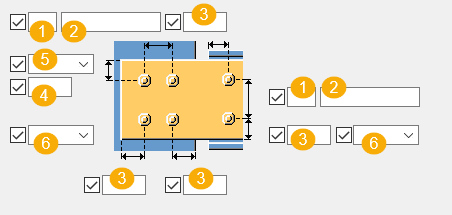
| Description | |
|---|---|
|
1 |
Number of bolts. |
|
2 |
Bolt spacing. Use a space to separate bolt spacing values. Enter a value for each space between bolts. For example, if there are 3 bolts, enter 2 values. |
|
3 |
Bolt edge distance. Edge distance is the distance from the center of a bolt to the edge of the part. |
|
4 |
Dimension for vertical bolt group position. |
|
5 |
Select how to measure the dimensions for vertical bolt group position.
|
|
6 |
Select the bolt type. |
Staggering of bolts
|
Option |
Description |
|---|---|
|
|
Default Not staggered AutoDefaults can change this option. |
|
|
Not staggered |
|
|
Staggered type 1 |
|
|
Staggered type 2 |
|
|
Staggered type 3 |
|
|
Staggered type 4 |
Bolt basic properties
|
Option |
Description |
Default |
|---|---|---|
|
Bolt size |
Bolt diameter. |
Available sizes are defined in the bolt assembly catalog. |
|
Bolt standard |
Bolt standard to be used inside the component. |
Available standards are defined in the bolt assembly catalog. |
|
Tolerance |
Gap between the bolt and the hole. |
|
|
Thread in mat |
Defines whether the thread may be within the bolted parts when bolts are used with a shaft. This has no effect when full-threaded bolts are used. |
Yes |
Cut length
Defines the depth at which Tekla Structures searches for the sections of the bolted parts. You can determine whether the bolt will go through one flange or two.
Slotted holes
You can define slotted, oversized, or tapped holes.

|
Option |
Description |
Default |
|---|---|---|
|
1 |
Vertical dimension of slotted hole. |
0, which results in a round hole. |
|
2 |
Horizontal dimension of slotted hole, or allowance for oversized holes. |
0, which results in a round hole. |
|
Hole type |
Slotted creates slotted holes. Oversized creates oversized holes. No hole does not create holes. Tapped creates tapped holes. |
|
|
Rotate Slots |
When the hole type is Slotted, this option rotates the slotted holes. |
|
|
Slots in |
Part(s) in which slotted holes are created. The options depend on the component in question. |
Bolt assembly
The selected check boxes define which component objects (bolt, washers, and nuts) are used in the bolt assembly.
If you want to create a hole only, clear all the check boxes.
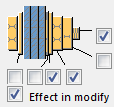
To modify the bolt assembly in an existing component, select the Effect in modify check box and click Modify.
Bolt length increase
Define how much the bolt length is increased. Use this option when, for example, painting requires the bolt length to be increased.

Angle bolts 1 / Angle bolts 2 tabs
Use the Angle bolts tabs to control the bolts that connect the clip angles.
Bolt group dimensions
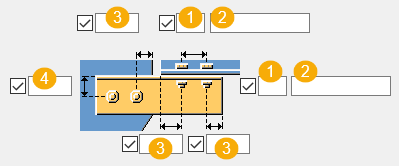
| Description | |
|---|---|
|
1 |
Number of bolts. |
|
2 |
Bolt spacing. Use a space to separate bolt spacing values. Enter a value for each space between bolts. For example, if there are 3 bolts, enter 2 values. |
|
3 |
Bolt edge distance. Edge distance is the distance from the center of a bolt to the edge of the part. |
|
4 |
Dimension for vertical bolt group position. |
Bolt distance
Define the minimum distance from the connection plate bolts to the intersection point of the main part and brace center lines. If a brace is perpendicular to the main part, the distance is measured from the main part center line to the nearest bolts.
| Option | Option |
|---|---|
|
|
|
Vertical bolt position
| Option | Description |
|---|---|
|
|
Bolt position from the clip angle edge. |
|
|
Bolt position from the secondary part center line. |
Bolt basic properties
|
Option |
Description |
Default |
|---|---|---|
|
Bolt size |
Bolt diameter. |
Available sizes are defined in the bolt assembly catalog. |
|
Bolt standard |
Bolt standard to be used inside the component. |
Available standards are defined in the bolt assembly catalog. |
|
Tolerance |
Gap between the bolt and the hole. |
|
|
Thread in mat |
Defines whether the thread may be within the bolted parts when bolts are used with a shaft. This has no effect when full-threaded bolts are used. |
Yes |
Cut length
Defines the depth at which Tekla Structures searches for the sections of the bolted parts. You can determine whether the bolt will go through one flange or two.
Slotted holes
You can define slotted, oversized, or tapped holes.

|
Option |
Description |
Default |
|---|---|---|
|
1 |
Vertical dimension of slotted hole. |
0, which results in a round hole. |
|
2 |
Horizontal dimension of slotted hole, or allowance for oversized holes. |
0, which results in a round hole. |
|
Hole type |
Slotted creates slotted holes. Oversized creates oversized holes. No hole does not create holes. Tapped creates tapped holes. |
|
|
Rotate Slots |
When the hole type is Slotted, this option rotates the slotted holes. |
|
|
Slots in |
Part(s) in which slotted holes are created. The options depend on the component in question. |
General tab
Click the link below to find out more:
Design tab
Click the link below to find out more:
Analysis tab
Click the link below to find out more:
Welds
Click the link below to find out more:
